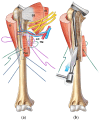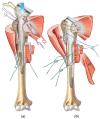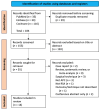Allograft Prosthetic Composite (APC) for Proximal Humeral Bone Deficiency in Revision Reverse Shoulder Arthroplasty: A Technical Note and Systematic Review
- PMID: 39458239
- PMCID: PMC11508849
- DOI: 10.3390/jcm13206290
Allograft Prosthetic Composite (APC) for Proximal Humeral Bone Deficiency in Revision Reverse Shoulder Arthroplasty: A Technical Note and Systematic Review
Abstract
Background: Proximal humeral bone deficiency in revision shoulder arthroplasty is an emerging and challenging problem as the use of reverse shoulder arthroplasty (RSA) increases. This paper presents a technical note discussing our detailed preoperative planning steps, surgical techniques, and their rationale in carrying out the use of an allograft prosthetic composite (APC) to address proximal humeral bone deficiency in revision RSA. The outcomes of this technique are also presented. This paper also presents a systematic review to further discuss the existing literature on RSA with APCs. Methods: The preoperative surgical planning and the surgical technique employed to execute proximal humeral reconstruction using APC during revision arthroplasty are discussed in the technical note. The preliminary clinical and radiological results of five patients who underwent revision shoulder arthroplasty with proximal humeral reconstruction using APCs are presented. The PRISMA guidelines were followed to perform the systematic review. A systematic search using PubMed, Embase, and Cochrane databases was conducted. All studies involving RSA and APCs were pooled, and the data were extracted and analyzed. Results: A total of 14 studies were eligible for inclusion in the systematic review, with a total of 255 patients and a mean follow-up of 57 months. All studies in the systematic review and the patients included in the author's case series showed improvements in the level of pain, range of motion, function, and satisfaction. Graft incorporation in the systematic review was 84%. Conclusions: Based on the available literature and the results of our case series, the use of an APC construct is a viable option for proximal humeral bone deficiency in revision shoulder arthroplasty.
Keywords: allograft prosthetic composite; preoperative planning; proximal humeral bone deficiency; revision shoulder arthroplasty.
Conflict of interest statement
K.I. and L.G. are employees of Akunah (Akunah, Brisbane, Australia). A.G. is the founder and CEO of Akunah (Akunah, Brisbane, Australia). H.I., W.K., M.K., J.M., and S.W. declare no conflicts of interest related to this paper. A.G. and K.C. are the Co-Directors of QUASR, which receives grant funding from Stryker, Zimmer Biomet, Australian Research Council, and QUT, none of which have any conflicts with this paper. In addition, the Australian Shoulder Research Fellowship receives an educational grant from both Arthrex Device Technology and Stryker, none of which are in conflict with this publication.
Figures









References
Publication types
LinkOut - more resources
Full Text Sources
Miscellaneous

